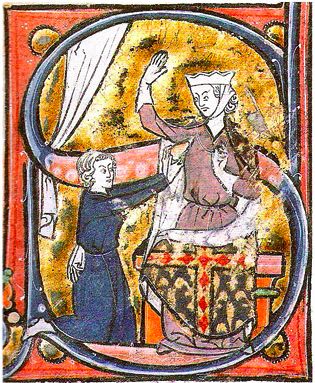The ❤️. When did it become a symbol of love? For that matter, why is it called a heart symbol, when it doesn't look like a human heart?
 |
| Illustration from a drop-letter in 'Roman de la poire,' which dates back to around 1250 CE. The first known depiction of a heart as a symbol of romantic love. |
We know that we associate the heart with emotions. And that became a symbol of romance in medieval Europe, particularly the Renaissance, when it figured art showing Christ and his 'sacred heart.' It also was used as one of the four suits in European playing cards. By the 1700s, it began featuring in Valentine’s Day cards.
I read also that a symbol much like it has been seen on cave paintings dating back to 8000 BCE or more, like before the last Ice Age, but what meaning those painters may have ascribed to it is unknown. And in the Voodoo religion, the heart icon is the symbol of Erzulie, the loa of love, beauty, and purity. In Ghana, the Asante used the symbol in Adinkra, hand-embroidered cloths that represented social thought and belief, to represent love.
But I digress. Why was this shape the symbol for a heart, which to our eyes, looks rather different?
One theory associates it with saunf, fennel. Or rather, silphium a species of giant fennel now extinct. Silphium grew on the North African coastline. Greeks and Romans used it as a spice, a medicine for coughs, but also as a contraceptive. Poets praised this latter quality. It was cultivated into extinction by the first century CE. In images from the era (the city-state of Cyrene, which prospered with the silphium trade, put the shape on its money, for one) the silphium seed looks like the ❤️.
Some theories say it is based on ivy or water-lily leaves. (Ancient Greeks associated ivy with Dionysus, god of sensual things, which may have lead to its association with sex and then romantic love.) Others say that that it was based on the shape of breasts or buttocks or the pubic mound or vulva or testicles.
The Catholic church's story is that a saint Margaret Mary Alacoque a vision in which the sacred heart of Jesus appeared to her in this shape, with thorns around it. This vision was in the 1600s, much after the symbol (sans thorns) was already well known, so doesn't explain the origins, but since the church had no small influence in Europe, it accounts for its further spread. (Before this, in heraldry, the heart signified sincerity, eventually became synonymous with the holy grail. Some playing cards use the holy grail instead of the heart symbol.)
Some scholars argue for a more simple evolution. They say it originates in the writings of Aristotle, who said the human heart had three chambers with a dent in the middle, and when artists in the Middle Ages drew representations of ancient texts, this is what they came up with. Some say says that the symbol does resemble the chambers of the heart cut open. Bird or reptile hearts are closer in shape to the symbol, and since early anatomical study was based on the dissection of animals, this sounds viable.
At any rate, most early graphic depictions in Europe were sort of pine-cone shaped, and upside-down, at least from our perspective. In the 1400s, a dent began to appear on the base, first small, then getting bigger. By the mid-1500s, it depiction on playing cards was the one we know today.
We no longer think of the heart as the seat of emotions, or of love, though it persists in language. And emoji. An example of iconographic inertia, to use a phrase coined by Nicholson Baker.
(All this is the product of one of those trips down rabbit holes when one goes to look up something. Maybe you'll find it interesting too.)
No comments:
Post a Comment